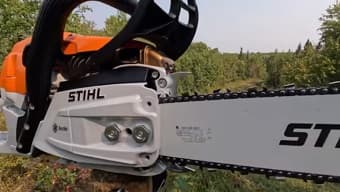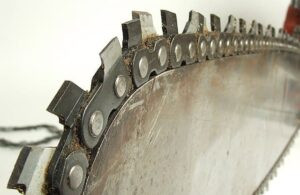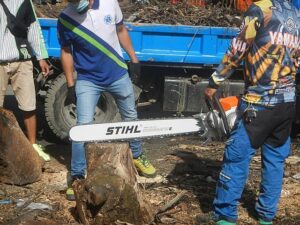As an Amazon Associate, this site earns commissions from qualifying purchases. For more information click here.
There are few things more alarming than a burning smell coming from your chainsaw. Whether it is gas or electric, a burning odor or worse smoke is a cause for concern. Do not throw away your chainsaw yet though, because there are solutions that you can try.
If your chainsaw smells like it is burning, the chain was probably installed backwards. It can also be due to lack of bar lubrication, a dull blade or the chain is too tight.
Before You Fix the Chainsaw
Before you attempt to fix that burning smell, there are a few things you need to go over. First, wear protective gear. The Forester Protective Clothing Kit includes chaps, safety glasses and a helmet. It is used by professionals so we recommend it.
Now we have to take a look at the signs. The burnt odor is just one symptom. The more signs you are aware of, the faster it will be to find the correct fix.
The symptoms of a burnt smelling chainsaw are:
- A burning smell on the engine, motor or blade
- Smoke coming from the chainsaw
- The chainsaw is very hot
- The blade is not cutting well
- The burning smell is accompanied by a gas-like odor
Once you have recognized the symptoms, it is time to check the chainsaw and fix it. Since there is potential hazard here, take all safety precautions.
- Wear chaps, gloves, eye protection and steel toe boots
- Keep flammable objects far away
- Fix the chainsaw outdoors
- Have your owner’s manual nearby
Now you are ready to repair the chainsaw and find the source of that smell. Let us look at the possible causes.

Chainsaw Chain is Backwards
If the chain is installed backwards, the chainsaw will not be able to cut properly. The engine is forced to exert more force to the point it starts to smoke. This can damage the engine and it also puts you at risk. Why? Because when you install a chain backwards, the sharp ends are pointed at you.
Solution. Install the chain in the right direction.
Installing a chainsaw chain can be tricky for beginners because it is hard to tell which direction is right. Here are some guidelines.
When you put on the chain on a chainsaw, the drive link and cutter must point forward. The drive link is the curved shape at the end of the chain. It has to point away from the bar. This applies to the cutter as well. If the chainsaw chain is backwards, follow these steps to install it in the right direction.
Step 1
Turn off the chainsaw. If it is electric, unplug the cord. Remove the spark plug.
Step 2
Use a socket wrench to remove the bolts on the bar and chain. You will see the chain tensioner.
Step 3
Use a screwdriver on the tensioner until it starts moving back.
Step 4
Remove the chain spool cover with the screwdriver. Make sure the wing nut is loose.
Step 5
The chain tensioner wheel is at the end of the bar. Turn it so that it is at the end. Get the chain and guide rail.
Step 6
The chain is on the guided bar. Use a screwdriver to remove it. When you are done, remove the guided bar and chain off the pulley.
Step 7
Hold the chain up. Look at the drive link and cutter. You are going to reinstall it but this time, the drive links and cutters must point away from you. In other words, the direction is the end of the bar.
Step 8
Pass the chain along the pulley. Put the guide back and push it to the pulley. Secure it place. Set the chain around the bar.
Step 9
Put the cover back on. Do not tighten the chain too much as you will likely need to adjust it. When you are done adjusting, tighten the bolts.
Turn the chainsaw on and give it a try. If it runs fine without any smell, you are done. If the chain is too loose or tight, check the solution below.
Chainsaw Chain is Too Tight
If the chain is too tight the engine will overheat. There has to be space for the chain to move, otherwise it will not be able to cut. The engine is just going to exert more force to make the chain move until it smokes and burns.
Solution. Adjust the chain tension.
You should be able to insert a coin between the chain and the bar. If not, the chain is too tight. Follow these steps to loosen it.
Step 1
Find the adjustment screw. It is usually under the bolts that hold the chain guide bar. Refer to your manual if uncertain.
Step 2
To loosen chain tension, turn the screw counterclockwise. To increase the tension, turn the screw clockwise. In this case you want to loosen the chain so adjust the screw counterclockwise.
Step 3
Make only small adjustments. You could end up with a very loose chain that is unusable. When you have adjusted the screw, check the chain if it is still too tight or not.
Step 4
When you are done adjusting, tighten all the bolts and screws on the chainsaw.
Chain Bar is Not Lubricated
Aside from the fuel tank, chainsaws have a bar and chain oil reservoir. This has to be filled with oil to keep the blade running. Without oil, the chainsaw will overheat and produce smoke.
Oil is the lubricant that keeps the engine running. Without it the friction will wear the components quickly and cause overheating.
Solution. Oil the bar and chain
Chainsaws run in such a way that the fuel tank and bar and chain reservoir empty at the same time. This means you have to refuel both, which is good so you do not forget later.
Step 1
Turn off the chainsaw. Place it on a table, workbench or any flat surface. Wait a couple of minutes for the fuel to settle and the engine to cool.
Step 2
Remove the lid on the bar and chain oil reservoir. Fill it with oil. If there is old oil, empty it first and clean any deposits. Fill with new oil. Do not put too much the liquid overflows.
The top chainsaw brands produce their own chain and bar oil. It is always a good idea to buy from the same manufacturer to ensure compatibility. This does not mean third party suppliers are no good. In fact, there are many options available too.
Step 3
Put the lid on and tighten it. If you have not already done so, refill the fuel tank as well. When you are done, the chainsaw is ready. Unlike a circular saw, a chainsaw requires more maintenance. Chainsaws are more powerful though. For more about chainsaws vs. circular saws you can check out this guide.
Dull Blade
If the chain has dulled, it will not cut as efficiently as before. The motor tries to apply more force to make the cut, but due to the dullness of the blade nothing happens. It reaches the point the engine overheats.
Solution. Sharpen the chain
You can sharpen a chainsaw with a file.
Step 1
Use a vise or clamp to hold the chainsaw in place. You can also remove the chain and put that in a vise instead.
Step 2
Tighten the chain by turning the adjustment screw clockwise. The chain should be tight but still capable of moving along the bar.
Step 3
Use a marker to mark the first chain tooth you will sharpen.
Step 4
Choose a file that corresponds with the chainsaw teeth. You can find the chainsaw teeth size in the owner’s manual.
Step 5
Position the file on the cutter notch. Slide the file forward, then lift it up and slide forward again. Do not file in a back and forth motion because it will damage the chain.
Repeat the movement 4-10 times per chain tooth. Repeat the process until all the chain teeth have ben sharpened.
After you are done, you can turn the chainsaw on. It should run smoothly and without the burnt odor. Of course you must not forget to refuel and check the other parts if they need cleaning.

I love the outdoors and all the tools for maintaining gardens, yards and lawns. The only thing I am more passionate about is sharing what I know about garden and outdoor equipment.


